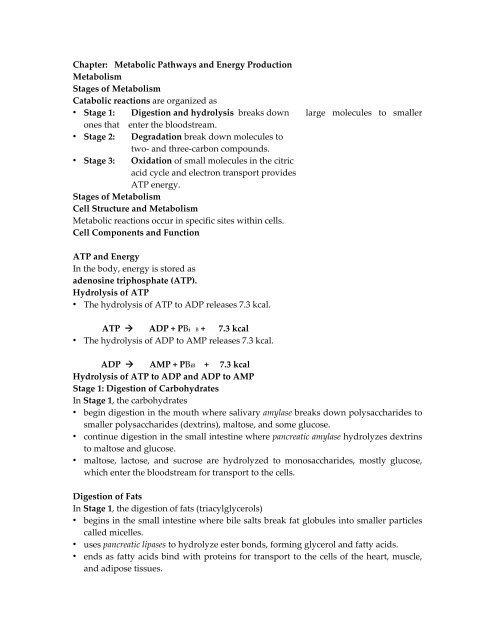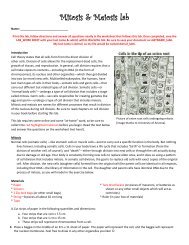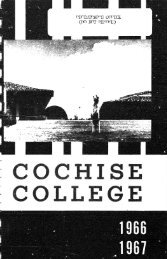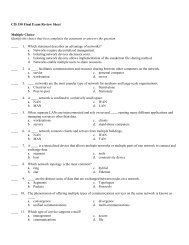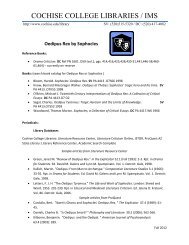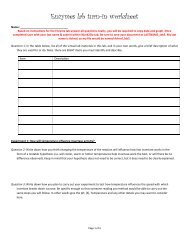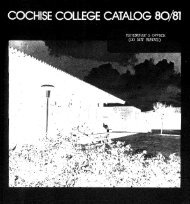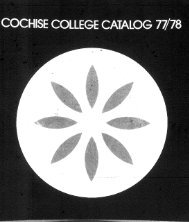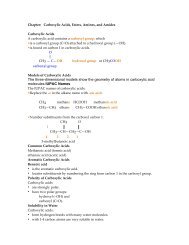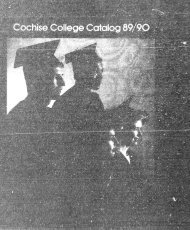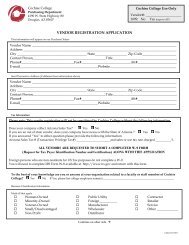You also want an ePaper? Increase the reach of your titles
YUMPU automatically turns print PDFs into web optimized ePapers that Google loves.
Chapter: Metabolic Pathways and Energy ProductionMetabolismStages of MetabolismCatabolic reactions are organized as• Stage 1: Digestion and hydrolysis breaks down large molecules to smallerones that enter the bloodstream.• Stage 2: Degradation break down molecules totwo‐ and three‐carbon compounds.• Stage 3: Oxidation of small molecules in the citricacid cycle and electron transport providesATP energy.Stages of MetabolismCell Structure and MetabolismMetabolic reactions occur in specific sites within cells.Cell Components and FunctionATP and EnergyIn the body, energy is stored asadenosine triphosphate (ATP).Hydrolysis of ATP• The hydrolysis of ATP to ADP releases 7.3 kcal.ATP ADP + PBi B + 7.3 kcal• The hydrolysis of ADP to AMP releases 7.3 kcal.ADP AMP + PBiB + 7.3 kcalHydrolysis of ATP to ADP and ADP to AMPStage 1: Digestion of CarbohydratesIn Stage 1, the carbohydrates• begin digestion in the mouth where salivary amylase breaks down polysaccharides tosmaller polysaccharides (dextrins), maltose, and some glucose.• continue digestion in the small intestine where pancreatic amylase hydrolyzes dextrinsto maltose and glucose.• maltose, lactose, and sucrose are hydrolyzed to monosaccharides, mostly glucose,which enter the bloodstream for transport to the cells.Digestion of FatsIn Stage 1, the digestion of fats (triacylglycerols)• begins in the small intestine where bile salts break fat globules into smaller particlescalled micelles.• uses pancreatic lipases to hydrolyze ester bonds, forming glycerol and fatty <strong>acids</strong>.• ends as fatty <strong>acids</strong> bind with proteins for transport to the cells of the heart, muscle,and adipose tissues.
Glycolysis: Overall ReactionIn glycolysis,• two ATP add phosphate to glucose and fructose‐6‐phosphate.• four ATP form as phosphate groups add to ADP.• there is a net gain of 2 ATP and 2 NADH.Pyruvate: Aerobic ConditionsUnder aerobic conditions (oxygen present),• three‐carbon pyruvate is decarboxylated.• two‐carbon acetyl CoA and COB2 Bare produced.Pyruvate: Anaerobic ConditionsUnder anaerobic conditions (without oxygen),• pyruvate is reduced to lactate.• NADH oxidizes to NADP +P allowing glycolysis to continue.Lactate in MusclesDuring strenuous exercise,• anaerobic conditions are produced in muscles.• oxygen is depleted.lactate accumulates.• muscles tire and become painful.After exercise, a person breaths heavily to repay the oxygen debt and reform pyruvate inthe liver.Citric Acid CycleIn Stage 3, the citric acid cycle• operates under aerobic conditions only.• oxidizes the two‐carbon acetyl group in acetyl CoA to 2COB2B.• produces reduced coenzymes NADH and FADHB2 Band one ATP directly.Citric Acid Cycle OverviewIn the citric acid cycle• acetyl (2C) bonds to oxaloacetate (4C) to form citrate (6C).• oxidation and decarboxylation reactions convert citrate to oxaloacetate.• oxaloacetate bonds with another acetyl to repeat the cycle.Reaction 1 Formation of CitrateOxaloacetate combines with the two‐carbon acetyl group to form citrate.Reaction 2 Isomerization to IsocitrateCitrate
• isomerizes to isocitrate.• converts the tertiary –OH group in citrate to a secondary –OH in isocitrate that can beoxidized.Reaction 3 Oxidative Decarboxylation (1)Isocitrate undergoes decarboxylation (carbon removedas COB2B).• The –OH oxidizes to a ketone releasing HP +P and 2eP ‐P .• Coenzyme NADP +P is reduced to NADH.Reaction 4 Oxidative Decarboxylation (2)α‐Ketoglutarate• undergoes decarboxylation to form succinyl CoA.• produces a 4‐carbon compound that bonds to CoA.• provides HP +P and 2eP ‐P to form NADH.Reaction 5 HydrolysisSuccinyl CoA undergoes hydrolysis, adding a phosphate to GDP to form GTP, a highenergy compound.Reaction 6 DehydrogenationSuccinate undergoes dehydrogenation• by losing two H and forming a double bond.• providing 2H to reduce FAD to FADHB2B.Reaction 7 Hydration of FumarateFumarate forms malate when water is added to the double bond.Reaction 8 DehydrogenationMalate undergoes dehydrogenation• to form oxaloacetate with a C=O double bond.• providing 2H for reduction of NADP +P to NADH + HP +P .Summary of in the Citric Acid CycleIn the citric acid cycle• oxaloacetate bonds with an acetyl group to form citrate.• two decarboxylations remove two carbons as 2COB2B.• four oxidations provide hydrogen for 3NADH and one FADHB2B.• a direct phosphorylation forms GTP.Overall Chemical Reaction for the Citric Acid CycleAcetyl CoA + 3NAD+ + FAD + GDP + PBiB + 2HB2BO 2COB2B + 3NADH + 2HP +P + FADHB2B + HS‐CoA + GTP
Electron Transport ChainComplex I NADH DehydrogenaseAt Complex I,• hydrogen and electrons are transferred from NADH to FMN.NADH + HP +P + FMN NADP + P + FMNHB2B• FMNHB2B transfers hydrogen to Fe‐S clusters and then to coenzyme Q reducing Qand regenerating FMN.FMNHB2 B+ Q QHB2B + FMN• QHB2B, a mobile carrier, transfers hydrogen to Complex III.Complex Succinate Dehydrogenase IIAt Complex II, with a lower energy level than Complex I,• FADHB2B transfers hydrogen and electrons to coenzyme Q reducing Q andregenerating FAD.FADHB2 B+ Q QHB2B + FAD• QHB2B, a mobile carrier, transfers hydrogen toComplex III.Complex CoQ‐Cytochrome c reductase IIIAt Complex III, electrons are transferred• from QHB2B to two Cyt b, which reduces Cyt b and regenerates Q.2Cyt b (Fe3+) + QH2 2Cyt b (Fe2+) + Q + 2H+• from Cyt b to Fe‐S clusters and to Cyt c, the second mobile carrier.2Cyt c (Fe3+) + 2Cyt b (Fe2+) 2Cyt c (Fe2+) + 2Cyt b (Fe3+)Complex Cytochrome c Oxidase IVIn the chemiosmotic model• protons (HP +P ) from Complexes I, III, and IV move into the intermembrane space.• a proton gradient is created.• protons return to matrix through ATP synthase, a protein complex.• the flow of protons provides energy for ATP synthesis (oxidative phosphorylation).ADP + PBiB + Energy ATPAt ATP synthase,• protons flow back to the matrix through a channel in the protein complex.• energy is generated to drive ATP synthesis.
Chemiosmotic Model of Electron TransportElectron Transport and ATPIn electron transport, sufficient energy is provided from• NADH (Complex I) oxidation for 3ATPs.NADH + 3ADP + 3PBiB NADP +P + 3ATP• FADHB2B (Complex II) oxidation for 2ATPs.FADHB2 B+ 2ADP + 2PBiB FAD + 2ATPATP from Electron TransportATP Energy from GlucoseThe complete oxidation of glucose yields• 6COB2B,• 6HB2BO, and• 36 ATP.ATP from GlycolysisIn glycolysis• glucose forms 2 pyruvate, 2 ATP and 2NADH.• NADH produced in the cytoplasm cannot enter the mitochondria.• a shuttle compound (glycerol‐3‐phosphate) moves hydrogen and electrons into themitochondria to FAD, which forms FADHB2B.• each FADHB2B provides 2 ATP.Glucose 2 pyruvate + 6 ATPATP from GlycolysisReaction Pathway ATP for One GlucoseATP from GlycolysisActivation of glucose‐2 ATPOxidation of 2 NADH (as FADHB2B)4 ATPDirect ADP phosphorylation (two triose)U4 ATP6 ATPSummary:CB6BHB12BOB6B 2 pyruvate + 2HB2BO + 6 ATPglucoseATP from Two PyruvateUnder aerobic conditions• 2 pyruvate are oxidized to 2 acetyl CoA and 2 NADH.• 2 NADH enter electron transport to provide 6 ATP.Summary:2 Pyruvate 2 Acetyl CoA + 6 ATPATP from Citric Acid Cycle
• One turn of the citric acid cycle provides3 NADH x 3 ATP = 9 ATP1 FADHB2B x 2 ATP = 2 ATP1 GTP x 1 ATP = U 1 ATPTotal = 12 ATPAcetyl CoA 2 COB2 B+B B12 ATP• Because each glucose provides two acetyl CoA, two turns of the citric acid cycleproduce 24 ATP.2 Acetyl CoA 4 COB2 B+B B24 ATPATP from Citric Acid CycleReaction PathwayATP for One GlucoseATP from Citric Acid CycleOxidation of 2 isocitrate (2NADH) 6 ATPOxidation of 2 α‐ketoglutarate (2NADH) 6 ATP2 Direct substrate phosphorylations (2GTP) 2 ATPOxidation of 2 succinate (2FADHB2B)4 ATPOxidation of 2 malate (2NADH) U 6 ATPTotal24 ATPSummary: 2Acetyl CoA 4COB2B + 2HB2BO + 24 ATPTotal ATP from GlucoseOne glucose molecule undergoing complete oxidation provides:From glycolysis6 ATPFrom 2 Pyruvate6 ATPUFrom 2 Acetyl CoA24 ATPOverall ATP Production for One Glucose:CB6BHB12BOB6B + 6OB2B + 36 ADP + 36 PBiB Glucose6COB2B + 6HB2BO + 36 ATPβ‐Oxidation of Fatty AcidsIn reaction 1, oxidation• removes H atoms from the α and β carbons.• forms a trans C=C bond.• reduces FAD to FADHB2B.β‐Oxidation of Fatty AcidsIn reaction 2, hydration• adds water across the trans C=C bond.• forms a hydroxyl group (—OH) on the β carbon.β‐Oxidation of Fatty AcidsIn reaction 3, a second
oxidation• oxidizes the hydroxyl group.• forms a keto group on the β carbon.• reduces NADP +P to NADH.β‐Oxidation of Fatty AcidsIn Reaction 4, fattyacyl CoA is split• between the α and β carbons.• io form Acetyl CoA and a shortened fatty acyl CoA that repeats steps 1 ‐ 4 of β‐oxidation.Cycles of β‐OxidationThe number of β‐Oxidation cycles• depends on the length of a fatty acid.• is one less than the number of acetyl CoA groups formed.Carbons in Acetyl CoA β‐Oxidation CyclesUFatty Acid (C/2) (C/2 –1)12 6 514 7 616 8 7β‐Oxidation and ATP• Activation of a fatty acid requires2 ATP• One cycle of oxidation of a fatty acid produces1 NADH 3 ATP1 FADHB2 B2 ATP• Acetyl CoA entering the citric acid cycle produces1 Acetyl CoA 12 ATPATP for Lauric Acid CB12BATP production for lauric acid (12 carbons):Activation of lauric acid‐2 ATP6 Acetyl CoA6 acetyl CoA x 12 ATP/acetyl CoA 72 ATP5 Oxidation cycles5 NADH x 3 ATP/NADH 15 ATP5 FADH2 x 2 ATP/FADH2 10 ATPTotal95 ATP
Ketone BodiesIf carbohydrates are not available• body fat breaks down to meet energy needs.• compounds called ketone bodies form.• if large amounts of acetyl CoA accumulate.• when two acetyl CoA molecules form acetoacetyl CoA.• when acetoacetyl CoA hydrolyzes to acetoacetate.• when acetoacetate reduces to β‐hydroxybutyrate or loses COB2B to form acetone, bothketone bodies.Ketosis occurs• in diabetes, diets high in fat, and starvation.• as ketone bodies accumulate.• when acidic ketone bodies lowers blood pH below 7.4 (acidosis).In diabetes• insulin does not function properly.• glucose levels are insufficient for energy needs.• fats are broken down to acetyl CoA.• ketone bodies form.Proteins provide• amino <strong>acids</strong> for protein synthesis.• nitrogen atoms for nitrogen‐containing compounds.• energy when carbohydrate and lipid resources are not available.In transamination• amino <strong>acids</strong> are degraded in the liver.• an amino group is transferred from an amino acid to an α‐keto acid, usually α‐ketoglutarate.• a new amino acid, usually glutamate, is formed.• a new α‐keto acid is formed.Synthesis of Amino AcidsIn humans, transamination of compounds from glycolysis or the citric acid cycleproduces nonessential amino <strong>acids</strong>.Oxidative deamination• removes the amino group as an ammonium ion from glutamate.• provides α‐ketoglutarate for transamination.
The urea cycle• removes toxic ammonium ions from amino acid degradation.• converts ammonium ions to urea in the liver.• produces 25‐30 g urea daily for urine formation in the kidneys.Carbon skeletons of amino <strong>acids</strong>• form intermediates of the citric acid cycle.• produce energy.Three‐carbon skeletons:alanine, serine, and cysteine pyruvateFour‐carbon skeletons:aspartate, asparagines oxaloacetateFive‐carbon skeletons:glutamine, glutamate, proline, arginine, histidine glutamateOverview of Metabolism• catabolic pathways degrade large molecules.• anabolic pathway synthesize molecules.• branch points determine which compounds are degraded to acetyl CoA to meetenergy needs or converted to glycogen for storage.• excess glucose is converted to body fat.• fatty <strong>acids</strong> and amino <strong>acids</strong> are used for energy when carbohydrates are not available.• some amino <strong>acids</strong> are produced by transamination.Structure and Stages of MetabolismPolysacaccharidesMonosaccharidesGlucoseGlycolysisATPATPPyruvateAcetyl CoA
8 1Kreb’s Cycle7 (Citric Acid Cycle) 2ATP6 3 CO25 4Electron Transport ChainH20ATP
Essay question for finals:What is the fate of absorbed glucose via bloodstream in cellular respiration? (Explain thedifferent steps of the process). You may use simple sketch to explain this process.This answer should be turned in as take home essay question worth 10 points towardsyour final grade.


